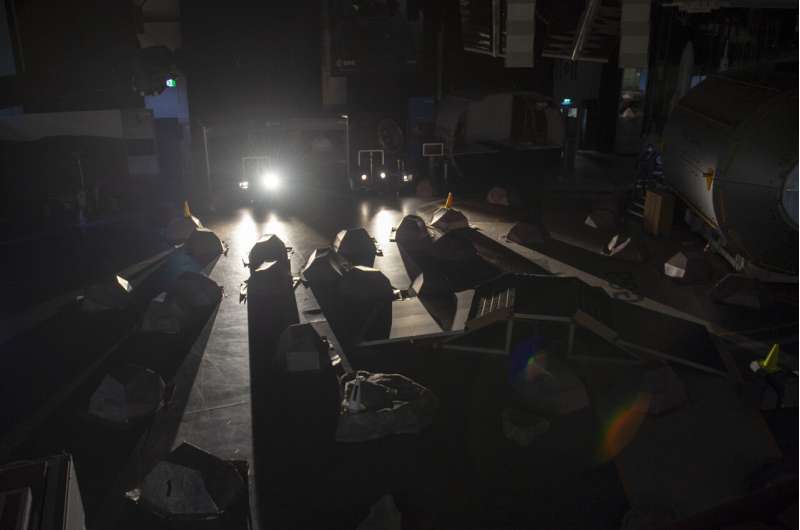Space Force discussions with private sector on future space architecture to remain classified
Wednesday, 22 September 2021 13:45
The first briefing with space and defense contractors planned by the Space Force’s Warfighting Analysis Center Oct. 27 will be at a classified facility.
Image: Gloomy moonscape created for rover test
Wednesday, 22 September 2021 13:21
A sun barely peeking over a cratered horizon, casting long shadows across a rocky moonscape: ESA's Erasmus Innovation Center was transformed into an analog of the moon's polar regions, in a dress rehearsal for an international rover competition.
The Space Resources Challenge—supported by ESA and the European Space Resources Innovation Center (ESRIC) in Luxembourg- is asking European (and Canadian) researchers and institutions to develop and demonstrate a system of one or more vehicles capable of prospecting resources on the moon in the near future.
Some 13 teams have been selected to participate in the Challenge's first field test in November, with €375 000 in ESA contracts to be awarded to the five winners, with a larger prize pool on offer after a follow-on field test next year.
"The focus here is really on prospecting—pinpointing promising resources within a difficult lunar environment then characterizing them in as much detail as possible, such as through spectral analysis," comments Massimo Sabbatini, managing the Erasmus Center, part of ESA's ESTEC technical center in the Netherlands.
"We're preparing for the first rover field test in November, which will take place in a larger location, still to be disclosed, but we decided to try out the challenge for ourselves first, here at Erasmus.
Call for media: invitation to join pre-launch press programme to see James Webb Space Telescope at Europe’s Spaceport before launch
Wednesday, 22 September 2021 12:00
Media representatives are invited to join a pre-launch press programme from 4-6 November at Europe’s Spaceport in French Guiana, to see the international James Webb Space Telescope being prepared for launch in December 2021.
US must prepare now to replace International Space Station
Wednesday, 22 September 2021 11:49 Policymakers warned Tuesday that Congress must move quickly to extend the life of the International Space Station to 2030 and develop new space stations or risk a costly gap in space exploration.
Abandoning the space station, which is to be decommissioned in 2028, without replacements would only serve the interests of China, which has a new space station in orbit, U.S. Rep. Brian Babin,
Policymakers warned Tuesday that Congress must move quickly to extend the life of the International Space Station to 2030 and develop new space stations or risk a costly gap in space exploration.
Abandoning the space station, which is to be decommissioned in 2028, without replacements would only serve the interests of China, which has a new space station in orbit, U.S. Rep. Brian Babin, Tycho Crater revealed in intricate detail
Wednesday, 22 September 2021 11:49 The National Science Foundation's Green Bank Observatory (GBO) and National Radio Astronomy Observatory (NRAO), and Raytheon Intelligence and Space (RI&S) have released a new high-resolution image of the Moon, the highest-ever taken from the ground using new radar technology on the Green Bank Telescope (GBT).
The resolution of the new Tycho Crater image is close to five meters by five mete
The National Science Foundation's Green Bank Observatory (GBO) and National Radio Astronomy Observatory (NRAO), and Raytheon Intelligence and Space (RI&S) have released a new high-resolution image of the Moon, the highest-ever taken from the ground using new radar technology on the Green Bank Telescope (GBT).
The resolution of the new Tycho Crater image is close to five meters by five mete A new understanding of galaxy evolution with the Roman Space Telescope
Wednesday, 22 September 2021 11:49 Galaxies change over time, but those changes take millions or billions of years - far longer than the human lifetime. To understand how galaxies evolve, astronomers therefore need to study large numbers of galaxies at various stages. NASA's Nancy Grace Roman Space Telescope will revolutionize galaxy studies since it can survey the sky up to thousands of times faster than can be done with Hubble
Galaxies change over time, but those changes take millions or billions of years - far longer than the human lifetime. To understand how galaxies evolve, astronomers therefore need to study large numbers of galaxies at various stages. NASA's Nancy Grace Roman Space Telescope will revolutionize galaxy studies since it can survey the sky up to thousands of times faster than can be done with Hubble NASA robots compete in DARPA's Subterranean Challenge Final
Wednesday, 22 September 2021 11:49 Led by NASA JPL, Team CoSTAR will participate in the SubT final this week to demonstrate multi-robot autonomy in a series of tests in extreme environments.
Eight teams featuring dozens of robots from more than 30 institutions, including NASA's Jet Propulsion Laboratory in Southern California, will converge in a former Kentucky limestone mine from Sept. 21 to 24 to participate in a series o
Led by NASA JPL, Team CoSTAR will participate in the SubT final this week to demonstrate multi-robot autonomy in a series of tests in extreme environments.
Eight teams featuring dozens of robots from more than 30 institutions, including NASA's Jet Propulsion Laboratory in Southern California, will converge in a former Kentucky limestone mine from Sept. 21 to 24 to participate in a series o Telespazio selects Hughes HeloSat for Airborne Satellite Communications
Wednesday, 22 September 2021 11:49 Hughes Network Systems reports that Telespazio, a joint venture between Leonardo (67%) and Thales (33%), has selected the Hughes HeloSat solution for satellite communications (SATCOM) for Leonardo's helicopters.
The solution combines the Hughes HM100 gateway and the HM400 modem for SATCOM on-the-move with technical support and systems integration. Once installed on helicopters like the Leo
Hughes Network Systems reports that Telespazio, a joint venture between Leonardo (67%) and Thales (33%), has selected the Hughes HeloSat solution for satellite communications (SATCOM) for Leonardo's helicopters.
The solution combines the Hughes HM100 gateway and the HM400 modem for SATCOM on-the-move with technical support and systems integration. Once installed on helicopters like the Leo Solar electric propulsion makes Psyche spacecraft go
Wednesday, 22 September 2021 11:49 When it comes time for NASA's Psyche spacecraft to power itself through deep space, it'll be more brain than brawn that does the work. Once the stuff of science fiction, the efficient and quiet power of electric propulsion will provide the force that propels the Psyche spacecraft all the way to the main asteroid belt between Mars and Jupiter. The orbiter's target: a metal-rich asteroid also call
When it comes time for NASA's Psyche spacecraft to power itself through deep space, it'll be more brain than brawn that does the work. Once the stuff of science fiction, the efficient and quiet power of electric propulsion will provide the force that propels the Psyche spacecraft all the way to the main asteroid belt between Mars and Jupiter. The orbiter's target: a metal-rich asteroid also call Northrop Grumman's LEO satellite payload for DARPA revolutionizes positioning, navigation and timing
Wednesday, 22 September 2021 11:49 The Defense Advanced Research Projects Agency (DARPA) Blackjack program has awarded Northrop Grumman Corporation (NYSE: NOC) a contract for Phase 2 development of an advanced, software-defined positioning, navigation and timing (PNT) payload, with options to build units destined for space flight.
The PNT payload work is led by Northrop Grumman's Future PNT Systems Operating Unit in Woodlan
The Defense Advanced Research Projects Agency (DARPA) Blackjack program has awarded Northrop Grumman Corporation (NYSE: NOC) a contract for Phase 2 development of an advanced, software-defined positioning, navigation and timing (PNT) payload, with options to build units destined for space flight.
The PNT payload work is led by Northrop Grumman's Future PNT Systems Operating Unit in Woodlan Nine ways AR and VR used on the International Space Station
Wednesday, 22 September 2021 11:49 Even the most highly trained and experienced person sometimes needs a hand. For astronauts aboard the International Space Station, that helping hand comes from other crew members, experts on the ground, and increasingly, in the form of augmented reality (AR) and virtual reality (VR).
The first use of AR on station, a set of high-tech goggles called Sidekick, provided hands-free assistance
Even the most highly trained and experienced person sometimes needs a hand. For astronauts aboard the International Space Station, that helping hand comes from other crew members, experts on the ground, and increasingly, in the form of augmented reality (AR) and virtual reality (VR).
The first use of AR on station, a set of high-tech goggles called Sidekick, provided hands-free assistance What's going on with the ozone?
Wednesday, 22 September 2021 11:49 World governments agreed in the late 1980s to protect Earth's ozone layer by phasing out ozone-depleting substances emitted by human activities, under the Montreal Protocol. The phase out of these substances has not only helped protect the ozone layer for future generations but has also protected human health and ecosystems by limiting the harmful ultraviolet radiation from reaching Earth. On 16
World governments agreed in the late 1980s to protect Earth's ozone layer by phasing out ozone-depleting substances emitted by human activities, under the Montreal Protocol. The phase out of these substances has not only helped protect the ozone layer for future generations but has also protected human health and ecosystems by limiting the harmful ultraviolet radiation from reaching Earth. On 16 China's cargo craft docks with space station core module
Wednesday, 22 September 2021 11:49 China's cargo spacecraft Tianzhou-3, carrying supplies for the upcoming Shenzhou-13 crewed mission, successfully docked with the space station core module Tianhe on Monday, according to the China Manned Space Agency (CMSA).
At 10:08 p.m. (Beijing Time), Tianzhou-3 completed a computer-orchestrated rendezvous and docking at the rear docking port of the Tianhe core module. The whole process
China's cargo spacecraft Tianzhou-3, carrying supplies for the upcoming Shenzhou-13 crewed mission, successfully docked with the space station core module Tianhe on Monday, according to the China Manned Space Agency (CMSA).
At 10:08 p.m. (Beijing Time), Tianzhou-3 completed a computer-orchestrated rendezvous and docking at the rear docking port of the Tianhe core module. The whole process Guardians begin migration to Space Force CACs
Wednesday, 22 September 2021 11:49 Space Force common access cards are being issued incrementally to Guardians after more than 18 months of collaboration across numerous organizations and five months of live testing with Guardians.
To produce a functioning USSF card, system and data owners across multiple agencies to include Air Force Personnel Center and the Defense Manpower Data Center, made critical systems changes to di
Space Force common access cards are being issued incrementally to Guardians after more than 18 months of collaboration across numerous organizations and five months of live testing with Guardians.
To produce a functioning USSF card, system and data owners across multiple agencies to include Air Force Personnel Center and the Defense Manpower Data Center, made critical systems changes to di How to catch a perfect wave: scientists take a closer look inside the perfect fluid
Wednesday, 22 September 2021 11:49 Scientists have reported new clues to solving a cosmic conundrum: How the quark-gluon plasma - nature's perfect fluid - evolved into matter.
A few millionths of a second after the Big Bang, the early universe took on a strange new state: a subatomic soup called the quark-gluon plasma.
And just 15 years ago, an international team including researchers from the Relativistic Nuclear Col
Scientists have reported new clues to solving a cosmic conundrum: How the quark-gluon plasma - nature's perfect fluid - evolved into matter.
A few millionths of a second after the Big Bang, the early universe took on a strange new state: a subatomic soup called the quark-gluon plasma.
And just 15 years ago, an international team including researchers from the Relativistic Nuclear Col 